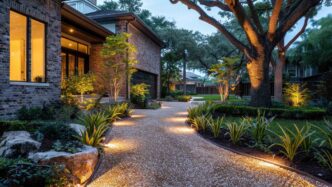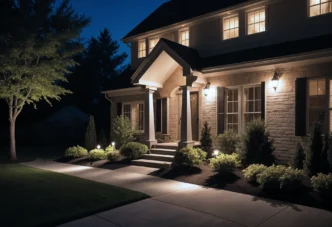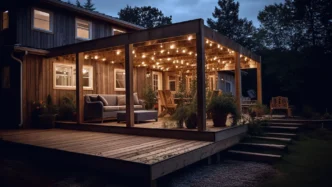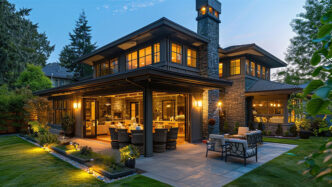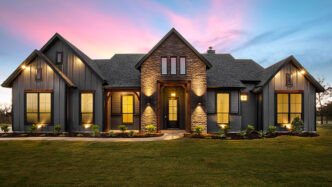Table of Contents: Feng Shui Lighting
- The Fundamentals of Feng Shui Lighting
- Placing Feng Shui Lights for Flow and Functionality
- Strike a Balanced Color Temperature and Mood
- Balance the Five Elements Through Feng Shui Lighting
- Avoid Common Feng Shui Lighting Mistakes
- Seasonal Adjustments for Optimal Chi
- Transform Your Outdoor Space with Feng Shui Lights
- FAQs About Feng Shui Lights
Feng Shui, the ancient Chinese practice of harmonizing our homes with nature, emphasizes the flow of “chi,” or energy, through thoughtful placement of elements. While often associated with interior design, Feng Shui principles can also maximize the flow of outdoor spaces, particularly through the art of landscape lighting.
By aligning light with the natural energy flow, you can create outdoor areas that feel serene, balanced, and inviting. In this guide, we’ll explore how to apply Feng Shui principles to landscape lighting to foster harmony and vitality in your outdoor spaces.
The Fundamentals of Feng Shui Lighting
Feng Shui revolves around balancing the five elements—Wood, Fire, Earth, Metal, and Water—and ensuring a smooth flow of chi. In outdoor spaces, lighting serves as a tool to highlight these elements while enhancing visibility and ambiance.
The key principles of Feng Shui include:
- Yin and Yang Balance: Harmony emerges from the interplay of opposites. Balanced lighting, which incorporates both brightness and shadow, creates a dynamic yet calming environment.
- Bagua Map: This essential Feng Shui tool divides spaces into zones corresponding to aspects of life such as health, wealth, and relationships. By aligning lighting to these zones, you can emphasize their associated energies.
- Energy Flow: Lighting plays a vital role in guiding chi throughout your space. Well-lit pathways and open areas ensure smooth and uninterrupted energy movement.
Placing Feng Shui Lights for Flow and Functionality
Strategic placement of lights is essential in Feng Shui to direct energy flow and create balance.
Here’s how to use lighting effectively in various parts of your landscape:
- Pathways: Pathways represent movement and transition. Illuminate walkways with evenly spaced lights to guide chi gently through the space. Use soft, warm lighting such as 12V low-voltage path lights to avoid harsh glare and ensure the pathway feels inviting.
- Entryways: The front entrance is the “mouth of chi,” where energy enters your home. Bright but welcoming lights attract positive energy and enhance security. Place fixtures such as LED uplights symmetrically on either side of the entrance to achieve balance.
- Water Features: Water symbolizes wealth and prosperity in Feng Shui. Lighting these features enhances their visual appeal and symbolic energy. Use underwater lighting such as submersible LED lights with adjustable colors for fountains or pools to create a serene glow.
- Gathering Areas: Outdoor seating or dining areas should feel cozy and nurturing. Layer your lighting design to create warmth and intimacy. Incorporate string lights or soft overhead fixtures to maintain a balanced ambiance. Consider placing uplights at the base of nearby trees to highlight their structure, and add string lights vertically along tree trunks or wrap them around branches to create a whimsical, inviting atmosphere.
- Gardens and Trees: Plants and trees represent the Wood element, symbolizing growth and vitality. Illuminate them subtly to honor their presence without overpowering them. Use uplights placed at the base of trees to cast a gentle glow upward, highlighting their height and structure. Position the spotlights slightly farther away to focus on unique details, like textured bark or striking branches. For a softer, wider illumination, adjustable flood lights can wash the surrounding area in light, enhancing both the trees and the nearby landscape.
Strike a Balanced Color Temperature and Mood
In Feng Shui, light color and temperature significantly influence mood and energy. Understanding the impact of these factors helps in creating your desired ambiance.
Follow these general guidelines for color temperature:
- Warm White (2700K – 3000K): Warm white tones exude relaxation and coziness, creating a welcoming and inviting atmosphere. These softer, warmer shades are perfect for pathways, entryways, and gathering areas where comfort and a sense of ease are paramount.
- Cool White (4000K – 5000K): Cool white lighting is crisp and bright, enhancing focus and clarity. This temperature range is ideal for task-oriented zones such as outdoor kitchens, workspaces, or any area where precision and visibility are essential. The clear, clean light of cool white helps to reduce eye strain and supports concentration, making it perfect for spaces where you’ll be doing a lot of work.
- RGB Lighting: RGB lighting offers dynamic and vibrant color options, allowing for a wide range of customization. While these lights are visually striking, they should be used sparingly to maintain a balanced atmosphere. By aligning RGB lighting with specific Feng Shui elements—such as blue for Water or green for Wood—you can emphasize energy shifts and create spaces that promote harmony and flow.
Balance the Five Elements Through Feng Shui Lighting
Each Feng Shui element has unique characteristics and corresponding colors. When we’re discussing Feng Shui elements, it’s more about symbolism and meaning, not necessarily using materials that are literally made from these elements.
Here’s how to consider the elements of Feng Shui in your landscape lighting design:
Wood: Feng Shui Lighting for Natural Vitality
Wood symbolizes growth and vitality, representing the natural cycle of life and renewal.
Colors such as green and brown evoke the earthy tones associated with nature. When it comes to lighting wooded areas with Feng Shui lights, you can make the wooden structures around your home the focal point and add green-tinted lights to highlight the connection to the outdoors.
Fire: Warm Lighting for Passionate Landscapes
In Feng Shui, fire is represented by the vibrant colors red and orange, which evoke feelings of enthusiasm and vitality.
If you’re looking for Feng Shui lighting ideas centered around fire, you can tap into the same sense of warmth, excitement, and intensity by using warm-colored uplights. These fixtures channel these elements and transform your yard into a cozy, passionate space.
Water: Reflecting Serenity with Tranquil Waterscapes
Water symbolizes wealth and abundance, often associated with fluidity, tranquility, and prosperity.
Colors such as blue and black reflect the calming, deep qualities of water. You can make your landscape lighting design more in tune with water by installing fixtures that reflect the light off of the water to create a serene, visually captivating atmosphere.
Earth: Soft Lighting for Stability and Harmony
Earth symbolizes stability and grounding, reflecting a sense of reliability and strength.
Colors such as yellow and beige complement earthy tones, creating a balanced and harmonious atmosphere. Lighting ideas for earth-focused spaces might involve illuminating stone pathways or planters with soft yellow lights to accentuate a natural and soothing environment.
Metal: Bright Lighting for Modern Elegance
Metal symbolizes clarity and precision, offering a sense of order and sophistication.
Metallic hues, such as silver and gold, paired with bright white light evoke a modern and structured aesthetic. Lighting ideas can include incorporating metallic fixtures or accentuating spaces with sharp, clean lines and bright white illumination.
Avoid Common Feng Shui Lighting Mistakes
Lighting can either harmonize or disrupt the energy flow of your outdoor space. Missteps in design often result in a discordant atmosphere that undermines the principles of Feng Shui.
To maintain harmony, steer clear of these pitfalls:
- Overlighting: Excessive brightness can overwhelm a space, throwing off the delicate balance of yin and yang energy. Overly bright areas can create discomfort, making it difficult to relax or focus. To maintain harmony, it’s important to aim for soft, layered lighting that gently illuminates without dominating the space.
- Glare: Harsh, direct light can feel aggressive and disrupt the flow of positive energy. Intense brightness can create visual strain, leading to feelings of discomfort or unease. To mitigate this, diffuse lighting or indirect placements are essential. Soft, ambient lighting helps create a more peaceful atmosphere, reducing harsh contrasts and allowing the space to feel inviting and balanced.
- Clutter: An overabundance of lighting fixtures can result in visual chaos, creating obstacles to the smooth flow of chi. Too many light sources compete for attention, making it difficult to maintain clarity and purpose. By prioritizing minimalism and simplicity in your lighting design, you can create a space where each fixture serves a distinct purpose, allowing chi to move freely and naturally throughout the environment.
- Neglecting Shadows: Shadows are an important element in creating depth and mystery, essential for a well-balanced and harmonious landscape. While lighting is necessary for visibility, shadows add visual intrigue and evoke a sense of creativity. Incorporating shadow play into your lighting scheme enriches the overall atmosphere, fostering a more engaging and energetically balanced environment.
Seasonal Adjustments for Optimal Chi
The rhythm of nature changes with the seasons, and so should your approach to outdoor lighting. Adapting your landscape lighting to reflect seasonal shifts ensures your space remains aligned with Feng Shui principles and the natural world around you.
Adjust your lighting to align with nature throughout each season:
Spring Tones for Renewal: Fresh Green Lighting and Your Yard
Spring symbolizes renewal and growth, which means it’s the perfect time to highlight blooming plants and fresh greenery with soft, invigorating green lighting.
The gentle illumination celebrates the season’s revitalization, encouraging a sense of vitality. By emphasizing natural elements with this uplifting color, you create a welcoming atmosphere that mirrors the beauty of new beginnings and flourishing life.
Capture Summer’s Glow with Vibrant Landscape Lighting
Summer calls for warmth, vibrancy, and outdoor gatherings. To capture the lively essence of the season, you can incorporate warm, energetic colors such as oranges, yellows, and reds into your outdoor spaces.
These hues energize their surroundings, creating a festive and inviting ambiance for summer barbecues, parties, and evening celebrations. The bright, cheerful lighting reflects the season’s carefree spirit and communal joy.
Harvest Autumn’s Abundance with Amber Tones
Autumn evokes feelings of warmth, abundance, and reflection. Amber-toned lights can be used to complement the season’s rich, earthy hues—and soft, golden shades create a cozy atmosphere that resonates with gratitude and harvest.
By lighting your outdoor spaces with amber tones, you can evoke the warmth and abundance of fall, while cultivating a sense of comfort and reflection.
Winter Coziness: Warm Lights for Chilly Nights
Winter can make for cold, long nights, making cozy lighting a must-have for maintaining harmony and a sense of comfort.
Warm white lighting has a soothing ambiance, counteracting the chill and ushering in a sense of togetherness. Accenting your yard with a soothing gentle glow can make for a restful environment that’s perfect for gathering with loved ones during the colder months.
Transform Your Outdoor Space with Feng Shui Lights
By integrating Feng Shui principles into landscape lighting, you can craft outdoor environments that radiate balance and positivity. Thoughtful lighting fosters a harmonious flow of energy that benefits all who enter.
Whether you’re designing a tranquil garden retreat or an inviting entertainment area, let Feng Shui guide your lighting choices for an outdoor space that truly shines.
FAQs About Feng Shui Lights
1. Can Feng Shui lights improve the resale value of my home?
Yes, applying Feng Shui lighting principles can subtly increase your home’s appeal and resale value by creating a harmonious and inviting atmosphere. Potential buyers often respond positively to thoughtfully illuminated outdoor spaces that emphasize balance and flow.
Well-placed lighting enhances curb appeal by highlighting pathways, landscaping features, and architectural details in a way that feels intentional yet calming. These elements resonate emotionally, offering a sense of serenity and order that aligns with the principles of Feng Shui, making the space more attractive to prospective buyers.
2. Can I add Feng Shui lights without completely redesigning my landscape?
Absolutely. You don’t need to start from scratch to infuse Feng Shui principles into your existing landscape. Simple adjustments, such as adding warm uplights to trees for the wood element or introducing soft blue lighting near water features to represent the water element, can make a significant impact.
Additionally, repositioning fixtures to improve the flow of light and balance between bright and shadowed areas can bring harmony to your outdoor space. Even small enhancements, like swapping cold, harsh lights for warm-toned LEDs, can align your lighting design with Feng Shui philosophies.
3. How can Feng Shui lights improve relaxation and stress relief?
Feng Shui lighting can create outdoor environments specifically designed to promote relaxation and reduce stress. By emphasizing natural elements like water features, soft lighting, and balanced shadows, you can foster a sense of calm and tranquility.
For example, gentle underwater lights in a fountain or pool mimic the soothing qualities of flowing water, while warm-toned pathway lights encourage a peaceful walk through your garden. These thoughtful design choices help to clear mental clutter, invite mindfulness, and create an outdoor retreat where you can unwind and recharge.
Join our Insider list and check out the different lighting options that we have to offer.
